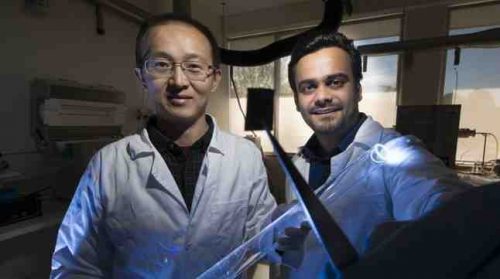International student Ankur Sharma invents semiconductor that can convert electricity into light very efficiently and is bendable
Sydney, October 5: As technology updates and improves constantly, it also leaves behind an enormous e-waste that all goes to the landfill. Australia produces 200,000 tonnes of e-waste every year, generated by discarded electronic devices.
We produce a billion phones every year and once the silicon chip in the phone has been updated, we go onto our next phone.
“We don’t know what to do with the old devices because every year a new phone is coming out”, said PhD researcher Ankur Sharma talking to Bharat Times.
But now “without the guilt of harming the environment at the cost of technology”, our mobile phones may be made reusing the same organic material for both the screen and the processor, promising to substantially reduce e-waste.
Ankur Sharma at the Australian National University (ANU) is making that happen very soon – when our mobiles will be thinner, faster and actually bendable.
Then based in Delhi, Ankur first arrived in Australia in 2014 as an exchange student while studying to become an engineer at the Aligarh Muslim University.
He was then offered a PhD and a year later he came back for his PhD at the ANU Research School of Engineering.
Ankur, who recently won the ANU 3-Minute Thesis competition, said the invention of the semiconductor was a major breakthrough in the field.
The semiconductor is made with organic and inorganic materials that can convert electricity into light very efficiently, and is thin and flexible enough to help make devices such as mobile phones bendable.
The organic component has the thickness of just one atom – made from just carbon and hydrogen, while the inorganic component has the thickness of around two atoms, according to the ANU team papers.

Much more efficient than conventional semiconductors made with inorganic materials such as silicon; the ANU team headed by Lead senior researcher Associate Professor Larry Lu, grew the organic semiconductor component molecule by molecule, in a similar way to 3D printing through a process called chemical vapour deposition.
“We have the potential with this semiconductor to make mobile phones as powerful as today’s supercomputers,” Ankur said.
The semiconductor is the part that does the computing, in the phone; and this invention is being hailed as the door to a new generation of high-performance electronic devices.
“The light emission from our semiconducting structure is very sharp, so it can be used for high-resolution displays and, since the materials are ultra-thin, they have the flexibility to be made into bendable screens and mobile phones in the near future.”
So we no longer have to worry about our phone falling and breaking – the product is so thin that it can bend without breaking and when this is commercialised, “our phones, tablets, television screens will be bendable in future,” Ankur added.
The research paper is published in journal Advanced Materials.
Ankur is now heading to Massachusetts Institute of Technology (MIT) for his next research project.
Vir Rajendra
